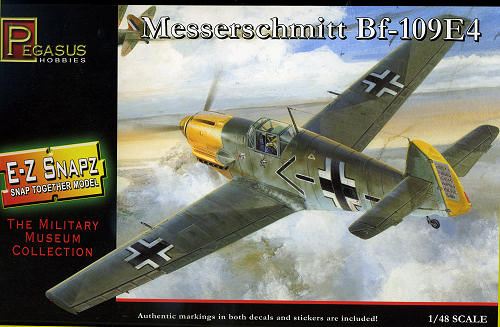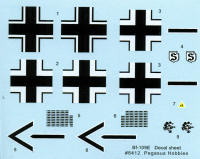
| KIT #: | 8412 |
| PRICE: | $10.95 SRP |
| DECALS: | One option |
| REVIEWER: | Scott Van Aken |
| NOTES: | Snap kit |

| HISTORY |
In late 1938, the "Emil" entered production. To improve on the performance afforded by the rather small 447-522 kW (600-700 hp) Jumo, the larger Daimler-Benz DB 601A engine was used, yielding an extra 223 kW (300 hp) at the cost of an additional 181 kg (400 lb). To test the new 1,100 PS (1,085 hp, 809 kW) DB601A engine, two more prototypes (V14 and V15) were built, each differing in their armament. While the V14 was armed with two 7.92 mm (.312 in) MG 17s above the engine and one 20 mm MG FF in each wing, the V15 was fitted with the two MG 17s mounted above the engine only. After test fights the V14 was considered more promising and a pre-production batch of 10 E-0 was ordered. Batches of both E-1 and E-3 variants were shipped to Spain for evaluation, and received their baptism of fire in the final phases of the Spanish Civil War.
E-4
The E-3 was replaced by the E-4 (with many airframes being upgraded to E-4 standards starting at the beginning of the Battle of Britain) which was different in some small details, most notably by using the modified 20 mm MG-FF/M wing cannon and having improved head armor for the pilot. With the MG FF/M it was possible to fire a new and improved type of explosive shell, called Minengescho▀ (or 'mine-shell') which was made using drawn steel (the same way brass cartridges are made) instead of being cast as was the usual practice. This resulted in a shell with a thin but strong wall, which had a larger cavity in which to pack a much larger explosive charge than was otherwise possible. The new shell required modifications to the MG FF's mechanism due to the different recoil characteristics, hence the MG FF/M designation.
The cockpit canopy was also revised to an
easier-to-produce, "squared-off" design, which also helped improve the
pilot's field of view. This canopy, which was also retrofitted to many E-1s
and E-3s, was largely unchanged until the introduction of a welded,
heavy-framed canopy on the G series in the autumn of 1942. The E-4 would be
the basis for all further Bf 109E developments. Some E-4 and later models
received a further improved 1,175 PS (1,159 hp, 864 kW) DB601N high-altitude
engine; known as the E-4/N this first appeared in July 1940. The E-4 was
also available as a fighter-bomber with equipment very similar to the
previous E-1/B. It was known as
E-4/B (DB 601Aa engine)
and E-4/BN
(DB 601N engine). A total of 561 of all E-4 versions were built, including
250 E-4, 20 E-4/N, 211 E-4/B and 15 E-4/BN.
| THE KIT |
 These
kits are designed for the youngsters and so are understandably not very fiddly.
In fact, fewer than two dozen parts total and most of the bits are rather beefy
compared to what you'd get in a Hasegawa or Tamiya kit. However, the kit appears
to be quite accurate in terms of shape, something that the more advanced modeler
would appreciate.
These
kits are designed for the youngsters and so are understandably not very fiddly.
In fact, fewer than two dozen parts total and most of the bits are rather beefy
compared to what you'd get in a Hasegawa or Tamiya kit. However, the kit appears
to be quite accurate in terms of shape, something that the more advanced modeler
would appreciate.  Instructions
are well drawn and provide six construction steps. There is no color information
during assembly, but a note in the painting guide states to do the interior in
RLM 02 with a black instrument panel. RLM 02 should also be used on the landing
gear and gear wells. The lone markings option is for Galland's 109E-4 in RLM
71/70/65 with a yellow nose and rudder. I'm thinking that should be RLM
71/02/65, but decide for yourself. No stickers this time, just a nicely done
water slide sheet without the swastika or any data markings.
Instructions
are well drawn and provide six construction steps. There is no color information
during assembly, but a note in the painting guide states to do the interior in
RLM 02 with a black instrument panel. RLM 02 should also be used on the landing
gear and gear wells. The lone markings option is for Galland's 109E-4 in RLM
71/70/65 with a yellow nose and rudder. I'm thinking that should be RLM
71/02/65, but decide for yourself. No stickers this time, just a nicely done
water slide sheet without the swastika or any data markings.
| CONCLUSIONS |
| REFERENCES |
http://en.wikipedia.org/wiki/Messerschmitt_Bf_109_variants
March 2011
Thanks to me for picking up this one.
If you would like your product reviewed fairly and quickly, please
contact
me or see other details in the
Note to
Contributors.